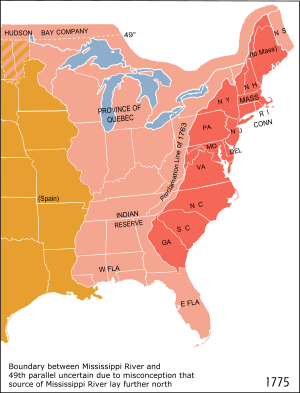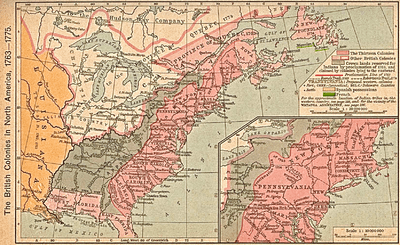Indian Reserve (1763) facts for kids
Quick facts for kids Indian Reserve |
|||||||||||||
|---|---|---|---|---|---|---|---|---|---|---|---|---|---|
| Territory of British America | |||||||||||||
| 1763-1787 | |||||||||||||
|
Flag
|
|||||||||||||
 Indian Reserve west of Alleghenies in 1775, after Quebec was extended to the Ohio River. Map does not reflect border as most recently adjusted by Treaty of Camp Charlotte (1774) and Henderson Purchase (1775) that opened West Virginia, most of Kentucky, and parts of Tennessee to white settlement. |
|||||||||||||
| History | |||||||||||||
|
• Royal Proclamation of 1763
|
7 October 1763 | ||||||||||||
|
• Treaty of Fort Stanwix
|
November 5, 1768 | ||||||||||||
|
• Vandalia (colony)
|
December 27, 1769 | ||||||||||||
|
• Quebec Act
|
January 13, 1774 | ||||||||||||
|
• Transylvania (colony)
|
March 14, 1775 | ||||||||||||
|
• Treaty of Paris (1783)
|
3 September 1787 | ||||||||||||
|
|||||||||||||
| Today part of | Canada United States |
||||||||||||
The Indian Reserve was a large area of land in North America. It was claimed by France and then given to Great Britain in 1763. This happened after the Seven Years' War, also known as the French and Indian War.
The British government decided to set this land aside for Native American tribes. This was done through a special rule called the Royal Proclamation of 1763. The British hoped to create a "barrier state" for Native Americans. This state would be west of the Appalachian Mountains, between the Ohio River and Mississippi River.
Even after the land was given to the United States in 1783, the British still wanted this Native American state. However, they gave up on the idea in 1814 after losing control of the area during the War of 1812.
In what is now the United States, the Indian Reserve covered land north of Florida and New Orleans. It stretched east of the Mississippi River and west of the Appalachian Mountains. This area was once the eastern part of Louisiana (New France).
In modern Canada, the reserve included land north of the Great Lakes. It was south of Rupert's Land, which belonged to the Hudson's Bay Company. It also created a buffer zone between the Province of Canada and Rupert's Land.
Contents
Protecting Native American Lands
The Royal Proclamation of 1763 was a very important document. It organized the new lands Great Britain had gained. It created three new colonies: East Florida, West Florida, and Quebec. The rest of the vast British territory was left for Native Americans.
The Proclamation drew a clear line along the Appalachian Mountains. This line marked the western boundary for British settlement. It was meant to protect Native American lands from settlers.
Any European settlers already living in the reserve, mostly French, were supposed to leave. They could also get special permission to stay. Many French settlers moved to New Orleans or to French land west of the Mississippi. This land later became Louisiana (New Spain) under Spanish rule. However, many settlers chose to remain, and the British did not force them out.
Land Treaties and Conflicts
In 1768, some Native American lands west of the Alleghenies were given to the colonies. The Cherokee tribe agreed to this at the Treaty of Hard Labour. The Six Nations (Iroquois) also agreed at the Treaty of Fort Stanwix.
However, other tribes, like the Shawnee and Mingo, still lived on and claimed these lands. They had not agreed to sell them. This disagreement led to a conflict called Lord Dunmore's War in 1774. The war ended with the Treaty of Camp Charlotte. In this treaty, the tribes agreed to accept the Ohio River as the new boundary.
The rules against settlement became a major issue leading up to the American Revolutionary War. In 1775, a large part of Kentucky was bought from the Cherokee in the Henderson Purchase. A Cherokee chief named Dragging Canoe did not agree to this sale. The British government also forbade settlement in this area.
Despite the rules, white pioneer settlers began moving into Kentucky in 1776. Dragging Canoe and his warriors fought against them in the Cherokee–American wars. These conflicts continued until 1794.
Key Events in the Indian Reserve
This timeline shows important moments related to the Indian Reserve.
Early Settlements and French Influence
- 1675: Jacques Marquette starts a mission post near Utica, Illinois.
- 1680: The Iroquois attack the Grand Village.
- 1680: Fort Crevecoeur is built near Peoria, Illinois.
- 1696: Cahokia, Illinois is founded.
- 1703: Kaskaskia, Illinois is founded.
- 1717: The Illinois Country is moved from French Canada's control to French Louisiana.
- 1720: Fort de Chartres is built on the Mississippi River.
- 1753: Fort Presque Isle is built near Erie, Pennsylvania.
- 1754: Fort Duquesne is founded at Pittsburgh.
The French and Indian War Years
- 1754: A French unit meets George Washington near Uniontown, Pennsylvania. A fight breaks out, starting the French and Indian War.
- 1754: Washington surrenders to the French at the Battle of Fort Necessity. This is his only surrender in battle. He signs a document taking responsibility for a French officer's death. This document helps widen the war into the global Seven Years' War.
- 1762: France secretly gives Louisiana (west of the Mississippi) to Spain. This is done in the Treaty of Fontainebleau (1762).
- 1763: France gives all its lands in modern Canada and east of the Mississippi to Britain. This is part of the Treaty of Paris (1763).
- 1763: King George III issues the Royal Proclamation of 1763. This sets aside the Indian Reserve. It orders settlers to leave and states that only the Crown can negotiate land deals with Native Americans.
Push for New Settlements

- 1764: It is announced that Spain now owns the west bank of the Mississippi in Louisiana.
- 1768: The Treaty of Fort Stanwix creates new boundary lines. The Iroquois give up much of Kentucky, West Virginia, and parts of Pennsylvania and New York.
- 1772: The Grand Ohio Company gets permission to settle the Vandalia colony. This colony is planned for south of the Ohio River, mostly in what is now West Virginia.
- 1774: The Quebec Act expands the borders of the Province of Quebec. It now includes all the Indian land in Canada and north of the Ohio River. This includes areas like Illinois, Indiana, Michigan, and Ohio. This act is seen as one of the "Intolerable Acts" that helped cause the American Revolutionary War.
- 1775: The Transylvania (colony) is founded in Kentucky by Richard Henderson. Daniel Boone creates the Wilderness Trail through Cumberland Gap. He then founds Boonesborough.
- 1775: Most of the Thirteen Colonies formally claim land extending west to the Mississippi River.
The American Revolutionary War and Its End
- 1778: Larger conflicts begin in the west with the Siege of Boonesborough. Daniel Boone is captured but escapes to help defend Boonesborough.
- 1779: American forces win battles in the Illinois campaign, at Fort Laurens, and the Battle of St. Louis.
- 1780: The British regain some control in the territory during Bird's invasion of Kentucky.
- 1781: British forces win at Lochry's Defeat and the Long Run massacre.
- 1781: Spain defeats Britain in Florida at the Siege of Pensacola.
- 1782: The British win the Battle of Blue Licks. This happens ten months after Charles Cornwallis, 1st Marquess Cornwallis surrendered at Yorktown.
- 1782: Americans win at the Siege of Fort Henry. This victory stops Britain from controlling the region.
- 1783: The Treaty of Paris (1783) officially ends the war. Britain gives the territory south of modern-day Canada to the United States. Florida is given to Spain.
- 1795: The Jay Treaty defines the borders between British North America and the United States. This ends British occupation south of the Great Lakes.
What Happened to the Indian Reserve?
After the United States gained control of the Indian Reserve area, it was gradually settled by European Americans. The land was divided into new territories and states. The first of these was the Northwest Territory.
Most Native Americans in the former Reserve were moved further west. This was part of a policy called Indian removal. After the Louisiana Purchase, the Indian Intercourse Act of 1834 created an Indian Territory west of the Mississippi River. This was meant to be a new home for relocated tribes.
However, this territory was also later divided into states for European American settlement. Today, only modern Indian Reservations remain within the boundaries of U.S. states.


